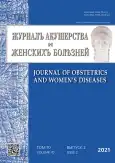Experience of measuring glutathione peroxidase activity in surgically induced endometrial-like lesions in rats
- Authors: Razygraev A.V.1,2, Baziyan E.V.2, Polyanskikh L.S.2, Petrosyan M.A.2,3
-
Affiliations:
- Saint Petersburg State Chemical and Pharmaceutical University
- The Research Institute of Obstetrics, Gynecology, and Reproductology named after D.O. Ott
- V.A. Almazov National Medical Research Center
- Issue: Vol 70, No 2 (2021)
- Pages: 55-61
- Section: Original study articles
- URL: https://journals.rcsi.science/jowd/article/view/52877
- DOI: https://doi.org/10.17816/JOWD52877
- ID: 52877
Cite item
Abstract
BACKGROUND: Endometriosis is known to be linked with altered activities of antioxidant enzymes and with their gene polymorphisms. Progestins are known to induce glutathione peroxidase activity in the endometrium and promote reduction of endometrial lesions. It could be useful to estimate the correlation between the activity of glutathione peroxidase within endometrial lesions and their degree of reduction.
AIM: The present study was aimed at estimating glutathione peroxidase activity in surgically induced endometrial-like lesions of different degree of reduction in rat model of endometriosis.
MATERIALS AND METHODS: The method for determining glutathione peroxidase activity using hydrogen peroxide as a substrate and 5,5’-dithiobis(2-nitrobenzoic acid) for estimation of residual reduced glutathione was applied for quantitative analysis of the enzyme activity in endometriotic foci, surgically induced in female Wistar rats. An assay of glutathione peroxidase activity in tissue homogenates was performed at 37°C in a reaction medium containing Tris-HCl buffer supplemented with tetrasodium ethylenediaminetetraacetate and sodium azide (pH 8.5) in the presence of 0.55 mM reduced glutathione and 0.192 mM hydrogen peroxide. Before adding trichloroacetic acid, 40-second incubation was used. The correlation between the specific activity of the enzyme and protein amount in endometriotic foci was estimated.
RESULTS: In a rat model of endometriosis, there was a high, well-determined glutathione peroxidase activity in endometriotic foci. For the same endometriotic tissue sample, the enzymatic activity was proportional to the amount of protein in the reaction mixture. The range of specific glutathione peroxidase activity was 2.43–6.45 micromoles of consumed glutathione per minute per milligram of protein (n = 7). In most reduced endometriotic foci (with the minimum amount of endometriotic tissue), the highest specific activity of glutathione peroxidase was found (the Spearman’s rho of –0.93 with p = 0.0067).
CONCLUSIONS: The method for determining glutathione peroxidase activity using hydrogen peroxide and 5,5’-dithiobis(2-nitrobenzoic acid) is convenient for working with the endometriotic tissue in a rat model of endometriosis. We can accept, with p < 0.01, that weight of endometriotic foci is negatively linked with specific glutathione peroxidase activity within their tissue. The results are analogous to the previously obtained data on catalase activity and suggest the involvement of both antioxidant enzymes in reduction of endometrial lesions.
Keywords
Full Text
##article.viewOnOriginalSite##About the authors
Aleksey V. Razygraev
Saint Petersburg State Chemical and Pharmaceutical University; The Research Institute of Obstetrics, Gynecology, and Reproductology named after D.O. Ott
Author for correspondence.
Email: a.v.razygraev@gmail.com
ORCID iD: 0000-0002-0544-9398
SPIN-code: 8623-7923
MD, PhD
Russian Federation, 3 Mendeleevskaya line, Saint Petersburg, 199034; Saint PetersburgElena V. Baziyan
The Research Institute of Obstetrics, Gynecology, and Reproductology named after D.O. Ott
Email: waz2107gen@yandex.ru
ORCID iD: 0000-0001-7837-3315
SPIN-code: 2232-9914
MD
Russian Federation, Saint PetersburgLyudmila S. Polyanskikh
The Research Institute of Obstetrics, Gynecology, and Reproductology named after D.O. Ott
Email: polyanskikh-83@mail.ru
ORCID iD: 0000-0001-9994-8341
SPIN-code: 2501-8880
MD
Russian Federation, Saint PetersburgMariya A. Petrosyan
The Research Institute of Obstetrics, Gynecology, and Reproductology named after D.O. Ott; V.A. Almazov National Medical Research Center
Email: mariya@labpharm.spb.ru
ORCID iD: 0000-0001-7347-6104
SPIN-code: 5329-5420
MD, PhD
Russian Federation, Saint Petersburg; Saint PetersburgReferences
- Ota H, Igarashi S, Sato N, et al. Involvement of catalase in the endometrium of patients with endometriosis and adenomyosis. Fertil Steril. 2002;78(4):804–809. doi: 10.1016/S0015-0282(02)03344-7
- Puy LA, Librach CL. A case-controlled analysis of catalase expression in endometriosis. Fertil Steril. 2001;76(3, suppl. 1):S149. doi: 10.1016/S0015-0282(01)02436-0
- Zarafshan SS, Salehi Z, Salahi E, et al. Polymorphism of catalase gene (CAT C-262T) in women with endometriosis. J Obstet Gynaecol. 2015;35(3):269–271. doi: 10.3109/01443615.2014.948402
- Razygraev AV, Petrosyan MA, Baziian EV, Polyanskikh LS. Activity of catalase in surgically induced endometrial-like lesions in rats. Journal of obstetrics and women’s diseases. 2019;68(6):57–63. (In Russ.). doi: 10.17816/JOWD68657-63
- Ota H, Igarashi S, Kato N, Tanaka T. Aberrant expression of glutathione peroxidase in eutopic and ectopic endometrium in endometriosis and adenomyosis. Fertil Steril. 2000;74:313–318. doi: 10.1016/S0015-0282(00)00638-5
- Torres WH. Biología de las especies de oxígeno reactivas. Mensaje Bioquimico. 2002;26:19–54. [cited: 2020 Dec 2]. Available from: http://static1.1.sqspcdn.com/static/f/1381323/18832492/1340082783193/Mensaje_Bioq02v26p019_Hansberg.pdf?token = %2BxnoB2oTZkYCHfk5sNZxT7gyf4Y%3D
- Petrosyan MA, Balashova NN, Polyanskikh LS, et al. Influence of progesterone analogs on endometrioid heterotopia in experimental model of endometriosis. Eksperimental’naya i Klinicheskaya Farmakologiya. 2018;81(7):14–19. (In Russ.). doi: 10.30906/0869-2092-2018-81-7-14-19
- Razygraev AV, Yushina AD, Titovich IA. Correction to: A method of measuring glutathione peroxidase activity in murine brain: Application in pharmacological experiment. Bulletin of experimental biology and medicine. 2018;165(4):589–592. (In Russ.). doi: 10.1007/s10517-018-4219-2
- Razygraev AV, Taborskaya KI, Petrosyan MA, Tumasova ZhN. Thiol peroxidase activities in rat blood plasma determined with hydrogen peroxide and 5,5’-dithio-bis(2-nitrobenzoic acid). Biomed Khim. 2016;62(4):431–438. (In Russ.). doi: 10.18097/PBMC20166204431
- Riddles PW, Blakeley RL, Zerner B. Ellman’s reagent: 5,5’-dithiobis(2-nitrobenzoic acid) — a reexamination. Analytical biochemistry. 1979;94(1):75–81. doi: 10.1016/0003-2697(79)90792-9
- Chesnokova LS, Voinova NE, Komkova AI, Lyanguzov AYu. Metody kolichestvennogo opredeleniia belka. In fermenty i nukleinovye kisloty. Ed. by S.N. Lyzlova, B.G. Vladimirov. Saint Petersburg; 1997. (In Russ.)
- r-project.org [Internet]. R Core Team. R: A language and environment for statistical computing. R Foundation for Statistical Computing, Vienna; 2017. [cited: 2017 May 5]. Available from: https://www.r-project.org/
Supplementary files








